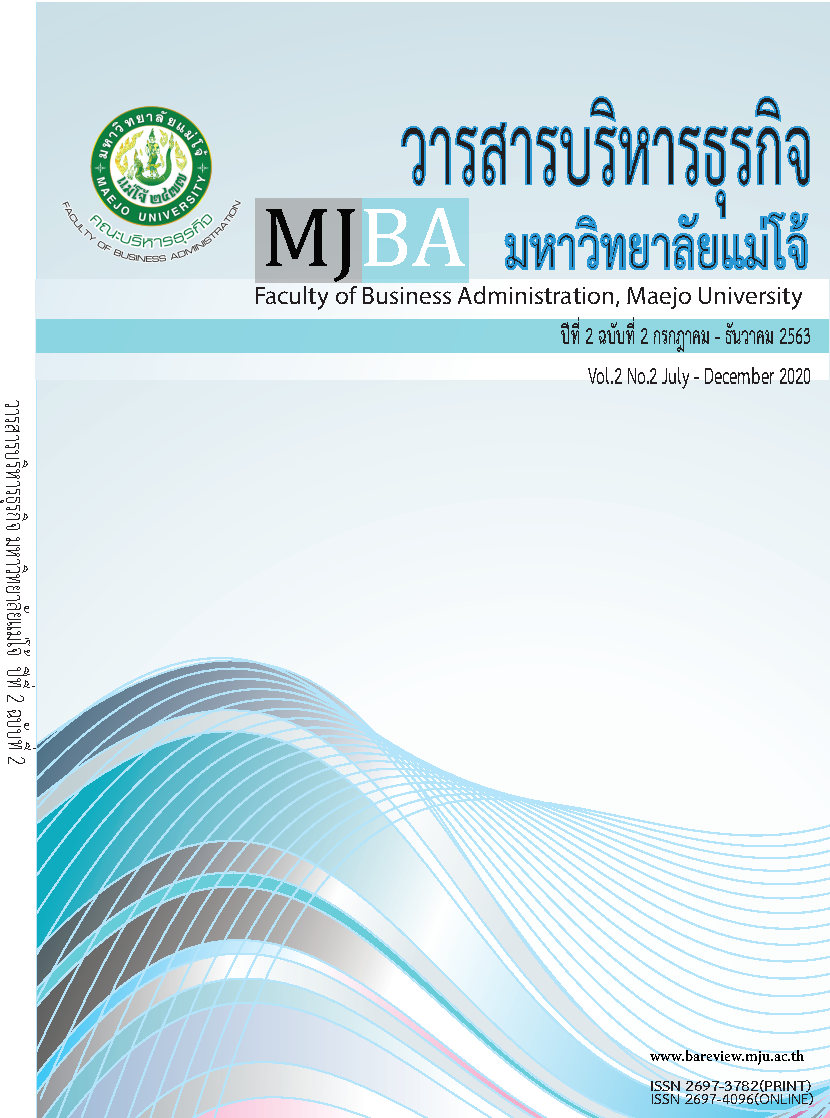Sources of Risk Analysis and Industrial Portfolio Allocation in the Stock Exchange of Thailand
DOI:
https://doi.org/10.14456/mjba.2020.6คำสำคัญ:
CES, Portfolio Allocation JEL Classification Codes: C32, G11, G32, SET Industry Group Indexบทคัดย่อ
This study investigates the appropriate portfolio allocation in the Stock Exchange of Thailand consists of eight industry groups (agriculture and food industry, consumer products, financials, industrials, property and construction, resources, services, and technology). It investigates risk contribution in each industry group, using the Component Expected Shortfall (CES) approach. This paper applies the dynamic conditional correlation multivariate GARCH model to measure the dynamic correlation between each pair of industry group index and Thailand's stock market system. The empirical results show that the financial sector contributes to the highest risk in the Thai stock market, while consumption introduces the lowest risk source. Thus, the investor should consider investing the money in the consumption sector to reduce portfolio risk.
เอกสารอ้างอิง
Banulescu, G. D., & Dumitrescu, E. I. (2015). Which are the SIFIs? A Component Expected Shortfall approach to systemic risk. Journal of Banking & Finance, 50, 575-588.
Bhatia, V., Das, S., & Mitra, S. K. (2018). Crude Oil Hedging with Precious Metals: a DCC-GARCH Approach. Academy of Accounting and Financial Studies Journal, 22(1), 1-8.
Bollerslev, T. (1990). Modelling the coherence in short-run nominal exchange rates: a multivariate generalized ARCH model. The review of economics and statistics, 72(3), 498-505.
Celik, S. (2012). The more contagion effect on emerging markets: The evidence of DCC-GARCH model. Economic Modelling, 29(5), 1946-1959.
Chang, C. L., McAleer, M., & Tansuchat, R. (2013). Conditional correlations and volatility spillovers between crude oil and stock index returns. The North American Journal of Economics and Finance, 25(2013), 116-138.
Cho, J. H. (2020). East Asian financial contagion under DCC-GARCH. International Journal of Banking and Finance, 6(1), 17-30.
Engle, R. (2002). Dynamic conditional correlation: A simple class of multivariate generalized autoregressive conditional heteroskedasticity models. Journal of Business & Economic Statistics, 20(3), 339-350.
Hanson, B., Klink, K., Matsuura, K., Robeson, S. M., & Willmott, C. J. (1992). Vector correlation: review, exposition, and geographic application. Annals of the Association of American Geographers, 82(1), 103-116.
Jorion, P. (2007). Financial risk manager handbook (Vol. 406). John Wiley & Sons.
Kanokporn, K. (2016). The Analysis of Volatility of Exchange-Traded Funds (ETF) Investment Returns Affecting Index in the Stock Exchange of Thailand (SET) Using Multivariate GARCH Models. Chiang Mai. Chiang Mai University.
Kong-ied, A., M.S. (2017). Return from Mutual Fund Portfolio Management in Thailand, Graduate School, Bangkok University. (pp. 1-93).
Liu, J., Sriboonchitta, S., Phochanachan, P., & Tang, J. (2015). Volatility and dependence for systemic risk measurement of the international financial system. In International Symposium on Integrated Uncertainty in Knowledge Modelling and Decision Making (pp. 403-414). Springer, Cham.
Liu, J., Song, Q., Qi, Y., Rahman, S., & Sriboonchitta, S. (2020). Measurement of Systemic Risk in Global Financial Markets and Its Application in Forecasting Trading Decisions. Sustainability, 12(10), 4000.
Markowitz, H. (1952). Portfolio selection. Journal of Finance, 7(1), 77–91.
Orskaug, E. (2009). Multivariate dcc–garch model: with various error distributions (Master's thesis, Institutt for matematiske fag).
Phochanachan, P., Liu, J., & Sriboonchitta, S. (2016). On Mathematical Modeling and Analysis of Co-Movement and Optimal Portfolios of Stock Markets. Thai Journal of Mathematics, 14(2), 283-303.
Tansuchat, R., Yamaka, W., Khemawanit, K., & Sriboonchitta, S. (2017). Analyzing the contribution of ASEAN stock markets to systemic risk. In Robustness in Econometrics (pp. 649-666). Springer, Cham.
The Stock Exchange of Thailand. (2015). History and roles, from https://www.set.or.th/th/about/overview/history_p1.html.
The Stock Exchange of Thailand. (2019). Annual Report 2019, from https://www.set.or.th/th/about/annual/files/annual_report_2562_thai_full.pdf.
Thitipatlertdech, N. M.S. (2016). The Effects of Macroeconomic Factors on Return of Portfolio, Graduate School, Bangkok University (pp. 1-46).
Wu, F. (2019). Sectoral contributions to systemic risk in the Chinese stock market. Finance Research Letters, 31(c), 386-390.
Yang, L., & Hamori, S. (2020). Forecasts of Value-at-Risk and Expected Shortfall in the Crude Oil Market: A Wavelet-Based Semiparametric Approach. Energies, 13(14), 3700.
Zinecker, M., Balcerzak, A. P., Faldzinski, M., Meluzin, T., & Pietrzak, M. B. (2016). Application of DCC-GARCH model for analysis of interrelations among capital markets of Poland, Czech Republic and Germany. Chapters, 1(67), 418-423.

ดาวน์โหลด
เผยแพร่แล้ว
รูปแบบการอ้างอิง
ฉบับ
ประเภทบทความ
สัญญาอนุญาต
ลิขสิทธิ์ (c) 2020 วารสารบริหารธุรกิจ มหาวิทยาลัยแม่โจ้

อนุญาตภายใต้เงื่อนไข Creative Commons Attribution-NonCommercial-NoDerivatives 4.0 International License.






